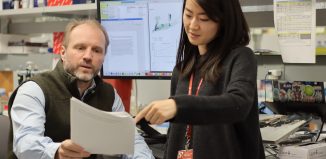Learning the secrets of nature’s building process
Nature has become a master builder, creating shells that blend an ability to resist wearing away by salt water and predators, with a beauty that the world’s best painters regularly try to emulate.
Scientists like Elaine DiMasi at Brookhaven National Laboratory are working to understand these natural manufacturing processes that may one day play a role in future innovations.
Using the National Synchrotron Light Source at BNL, DiMasi has studied the molecular steps in the so-called biomineralization process. Biomineralization usually hardens or stiffens tissues, although it can have other applications, including some that are detrimental to health, such as kidney stones.
“The question is how much can be mimicked without being an organism,” she said, of understanding and copying the steps that produce some of nature’s most durable material. “There are a lot of people who are well-motivated and funded who are trying to figure out the trick on the chemistry end.”
DiMasi, who earned her Ph.D. in physics from the University of Michigan in Ann Arbor, has put her own research on the back burner as she works on enhancing scientists’ ability to see these steps through the planning and refinement of the NSLS-II. The new light source, which is expected to be completed in 2015, will produce X-rays that are 10,000 times brighter than its predecessor, which was built in 1982.
DiMasi said she has gone through numerous meetings where she participates in discussions about the design optics. She said she’s learning some of the details on the fly and that it’s been “a pleasure to study and learn something new.”
While working on the NSLS-II, DiMasi recently finished co-editing a handbook called “Biomineralization Sourcebook: Characterization of Biominerals and Biomimetic Materials,” which is due out next March.
“That’s a big weight off my shoulders,” she said.
DiMasi said the book’s audience could include nontechnical readers because some of the chapters in the 600-page book include history.
In one chapter, the book examines naturalist drawings that are 100 to 200 years old and compares them to photographs.
Laurie Gower, an associate professor at the University of Florida in the Materials Science and Engineering department, said she originally recruited DiMasi to co-edit the book. DiMasi, however, wound up doing more than half the work, Gower said, because of when the contributors submitted their chapters.
DiMasi is looking forward to future collaborations at the NSLS-II. One of her roles is to understand how the molecules connect in long range order to make a thread or sheath. She said her work can also explore the different chemical compositions in different places in biological materials.
“Our measurements could show what molecular material it was,” she said. “It could show that one place was harder or one place was more or less dense. We could see the chemical composition or crystal structure.”
“There are some inspirations from biomineralization already,” she said. “Bone is constantly broken up and dissolved by cells.” When people exercise, pieces of mineral break down, which “sends a signal to regurgitate new materials.”
A resident of Miller Place, DiMasi said she grew up with “National Geographic” magazines, encyclopedias and a healthy dose of curiosity.
“One time,” she said, “I got into an argument with my dad. He was speculating how the system of the eyeball worked. I went off to check a book and I overheard my dad say, ‘She’s trying to prove me wrong.’ I particularly enjoyed overhearing Mom reply, ‘and she will because you are wrong.’”
A keyboard player, songwriter and arranger, DiMasi is a member of a band called Indulgent Lucie, which mixes pop and reggae combinations. DiMasi, who plays the oboe and English horn, celebrated completing the book by taking an online music class.
Gower said DiMasi, who has a strong reputation in the world of biomineralization, has impressed her with her adventurous spirit.
“She drove across the country” with her dog, Gower said. “She’s very independent.”
As for her work, DiMasi said she’s excited by the constant struggle to understand natural processes.
“It’s one thing to mimic the shell layers of an organic material,” she said. “It’s another to know what is deposited, step by step, when an organism is growing.”






